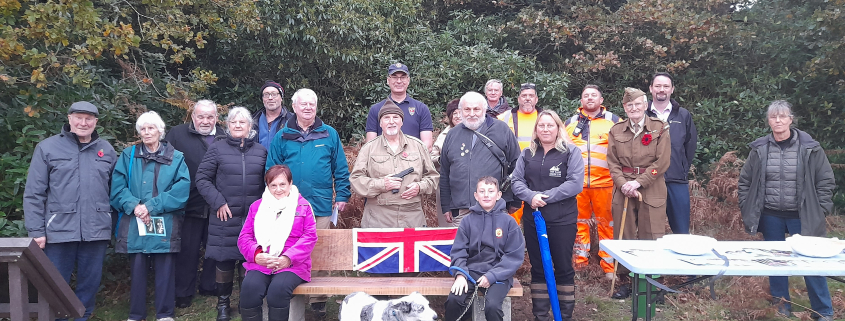Unveiling of the Binnegar Operational Base (OB) Memorial Benches
A ribbon cutting ceremony took place on Monday 14 November 2022 by Councillor Barry Quinn, to officially unveil the Binnegar Operational Base (OB) Memorial Benches in Binnegar Lane, Wareham.
In 2017, the remains of an OB for one of these Auxiliary Units was discovered during the quarry expansion. During excavation by Raymond Brown Quarry Products, experts were called in from Historic England, the County Archaeologist and Coleshill Auxiliary Research Team (CART) to assess and excavate the site and record findings. This OB is now believed to be that of the Wareham Patrol as local knowledge and research has not found any link to the East Stoke Platoon of the Home Guard. The findings, together with more details are documented on the CART website: https://www.staybehinds.com/the-coleshill-auxiliary-research-team
Research and investigations conducted by CART volunteers have shown that there were a number of Auxiliary Unit OB’s in Purbeck with at least four patrols. The cellular structure of the Auxiliary Unit Patrols meant that no one patrol had knowledge of the others or where their OB was. Such tight security meant that patrols were less likely to be compromised in the event of capture.
Two memorial benches have been constructed from blocks and ventilation pipes salvaged from the OB, with wood from an oak tree felled in the vicinity. They commemorate the men of the Auxiliary Unit who manned the OB but received no real recognition after the war, being bound to secrecy by the Official Secrets Act.
After the retreat from Dunkirk, the country was under threat of invasion and this vantage point may well have been an observation post (OP) for members of the East Stoke Home Guard. Or, it may have been members of the secret Auxiliary Units, Britain’s wartime resistance in waiting and often referred to as “Churchill’s Secret Army” that lay up awaiting their chance to strike at the Nazi invaders. The Auxiliary Units were set up in 1940 in case of a Nazi invasion drawn from the Home Guard and local civilians. Their role was to hide underground whilst the first wave of an invasion passed by and then emerge to sabotage supplies, transport and communications to hamper the German forces and allow a counter attack. Made up of six to seven men in a patrol, they were taught demolition and issued with large quantities of explosives and weapons. Each patrol had an underground hideout known as an Operational Base (OB) where they could rest and store their supplies, it would be carefully camouflaged to avoid discovery. The men were told their life expectancy after invasion could be just a couple of weeks.
Councillor Barry Quinn commented: “ I am very pleased that this project has finally come to fruition. It has really been a team effort involving volunteers from East Stoke and CART, working with our sponsors Raymond Brown, Bindon Engineering and Holme Sawmill to deliver a community asset which both tells the historical narrative and provides a place of rest for users of the bridleway to take in a beautiful view. I hope it will be enjoyed by locals and visitors for years to come.”
“We were delighted to support CART in investigating this important part of local history, which has helped piece together part of everyday life for an Auxiliary Unit Patrol and their Operational Base during war time. We hope that the benches and interpretation board serve as a reminder of those who were prepared to lay down their lives for our country.” Said Rob Westell, Raymond Brown Estates and Planning Director.


